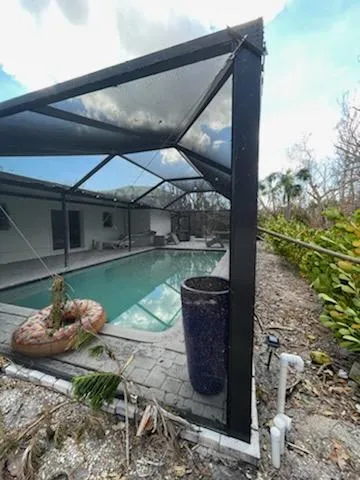Pool and Screen Enclosure Tips

Preparing Your Patio or Pool Screen Enclosure for a Hurricane
“If you know a hurricane is headed for your location, I recommend cutting a large section of screen on all sides of your enclosure in order to allow the wind to come through.” - Clayton Jorge, Owner Seaside Screen Enclosures- SW Florida
Introduction:
Living in Southwest Florida means enjoying beautiful weather most of the year, but it also means preparing for hurricane season. If you have a patio or pool screen enclosure, taking proactive steps to protect it can prevent significant damage and ensure your outdoor space remains safe and functional. Here’s a comprehensive guide on how to prepare your patio or pool screen enclosure for a hurricane.
Hurricane Ian damaged pool screen enclosure on Sanibel Island
1. Inspect and Repair
Before hurricane season begins, conduct a thorough inspection of your screen enclosure. Look for any signs of wear and tear, such as loose screws, damaged screens, or weakened structural elements. Address these issues promptly to ensure your enclosure is in the best possible condition to withstand strong winds and heavy rain. If necessary, hire a professional to perform any repairs to ensure they are done correctly and safely.
2. Reinforce and Secure
To enhance the stability of your screen enclosure, consider reinforcing its structure. You can install additional support beams or brackets to provide extra strength. Make sure all bolts, screws, and fasteners are tightened securely. In areas prone to severe weather, some homeowners opt for hurricane braces or straps that add an extra layer of protection against high winds.
3. Remove Loose Items
Loose items in and around your patio or pool area can become dangerous projectiles during a hurricane. Remove furniture, potted plants, pool toys, and any other items that are not securely anchored. Store these items indoors or in a secure shed. For larger, heavier items that cannot be moved, use bungee cords or straps to tie them down securely.
4. Trim Surrounding Trees
Trees and branches can cause significant damage to your screen enclosure if they break during a hurricane. Trim any overhanging branches or nearby trees to minimize the risk. Removing dead or weak branches can prevent them from becoming hazards during strong winds.
5. Protect Screens
While the primary structure of your screen enclosure needs reinforcement, don’t forget about the screens themselves. If possible, remove the screens from their frames and store them safely indoors. If you cannot remove the screens, find a large section of screen on all sides of your enclosure, and cut it diagonally from top to bottom on all sides of your enclosure. This not only protects the screens from being torn but also reduces wind resistance, lowering the risk of structural damage to the enclosure. It's much cheaper to replace the screen in those sections, than it is to replace the entire damaged structure!
6. Secure Doors and Windows
Ensure all doors and windows leading to your enclosed patio or pool area are securely closed and locked. Install storm shutters or plywood panels on glass doors and windows to protect them from flying debris. If your screen enclosure has any large openings, consider covering them with storm panels or heavy-duty tarps.
7. Turn Off Electrical Equipment
If you have any electrical equipment or appliances in your patio or pool area, such as lights, fans, or pool pumps, turn them off and unplug them. Water and electricity are a dangerous combination, and it’s best to minimize the risk of electrical hazards during a storm.
8. Plan for After the Storm
After the hurricane passes, inspect your screen enclosure for any damage. Take photographs for insurance purposes and contact a professional if you need repairs. Promptly addressing any issues can prevent further damage and ensure your enclosure is ready for the next storm.
Call Seaside Screen Enclosures for more information on preparing for an impending Hurricane

